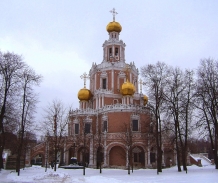Fili: Mansion of Lev Naryshkin
Fili (or Khvili) is a historical locality in the area of a former village at the mouth of the Filka (Khvilka or Khilka) River, the right tributary of the Moskva River. According to the Cadasters of 1627 and 1628, Khvili village with its wooden Church of the Intercession of the Theotokos was an old estate of the Mstislavskys princely family which was owned by the elderly nun Princess Irina Ivanovna, the last representative of the family. After her death the village was signed over to the Palace Department which further gave it to the estate of Ilya Danilovich Miloslavsky, the father-in-law of Tsar Aleksey Mikhailovich. After his death in 1668 — or, according to other sources, after the death of Ivan Mikhailovich Miloslavsky in 1685 — Khvili was returned to the Crown.
On July 11, 1689 — that is before the fall of the Regency of Sophia Alekseevna — Tsars Peter I and Ivan V and Tsarevna Sophia decreed to transfer Fili to the estate of Lev Naryshkin. As early as the next year, Naryshkin set up a manor by building a mansion, laying out a garden, and founding a stone church of the Intercession of the Theotokos on the site of the wooden one.
The church was designed to commemorate the rescue of Lev Naryshkin during the uprising of Streltsy (shooters) in 1682 which took lives of his two brothers, Ivan and Afanasiy. The upper church is dedicated to the Miraculous Image of the Savior in front of which Lev Naryshkin prayed in the Kremlin Palace during the Streltsy massacre.
After the fall of the government of Princess Sophia, boyar Lev Naryshkin (1664-1705), who was the brother of mother of Peter I Tsarina Natalia Kirillovna, became head of the Ambassadorial Prikaz (Office). He was member of a council comprised of four boyars which was established to manage the state while Peter I was on the Grand Embassy expedition in Europe. Lev Naryshkin also owned neighboring Kuntsevo, several estates near Moscow, namely Medvedkovo, Petrovskoye, Chashnikovo and Cherkizovo, and the Tula iron works which produced iron parts for ships of the Azov fleet, cannon balls and bombs.
Built in 1690–1694, the Church in Fili is a masterpiece of the so-called Naryshkin style. It is a stepped, centric temple standing on a high basement (known as “podklet” in Russian) which houses the Church of the Intercession of the Theotokos. The basement is surrounded by an open gallery resting on an arcade with three wide flights of steps. The building ends with three tapering octagonal structures — the middle one is a bellcote and the upper one is crowned with a dome. The facades of the temple are decorated with white stone columns which have figured cornices with elegantly carved “crests”. The crest shape is also found in the finials of the window surrounds.
The architect of the church is unknown. The interiors of the upper temple dedicated to the Feast of the Transfiguration are unique in terms of the degree to which they survived to this day. The church features a masters loft and a nine-tier iconostasis made by Belarusian workers from the Armory according to drawings of icon painter Karp Zolotaryov. Some researchers see the facial features of young Peter I in the face of Archdeacon Stephen found on the altar gates.
The lower Church of the Intercession of the Theotokos has an oak Lord’s table surviving from the original wooden temple, which is a uniquely old item for Moscow.
The first time Peter I visited Fili was on the feast of the Intercession of the Theotokos on September 30, 1683. Later, while the estate was owned by Naryshkin, he visited it regularly to attend at dinner parties or patronal festivals. Peter’s visits in 1690, 1692 and 1693 were recorded in the “Diary” by his associate Patrick Gordon who accompanied the Tsar. The Tsar granted 400 chervonets (gold coins) for the construction of a new church. The legend says that after the capture of Narva in 1704, Peter gave the Fili Church stained-glass windows brought from Narva.
In August 1697, Lev Naryshkin received the Danish Ambassador Paul Heins in Fili and gave a dinner in his honor. In 1699, the Church of the Intercession of the Theotokos in Fili could be seen by imperial ambassadors who were given a farewell dinner at the manor.
Fili was inherited by Alexander Naryshkin (1694-1746), Peter I’s cousin and favorite. In 1708, Alexander Naryshkin and other boyar tweens were sent to Western Europe to learn seamanship. Since 1715, he lived in Italy and France before he returned to Russia in 1721 to be promoted to the rank of lieutenant and appointed to work at the Admiralty Office, and a year later, he was appointed director of the Naval Academy.
Alexander Naryshkin’s sons divided Fili and Kuntsevo between them, with Fili going to his son Alexander (1726–1795).
During the Patriotic War of 1812, a military council at which Mikhail Kutuzov decided to leave Moscow took place in a peasant hut in the village of Fili on September 1 (13), 1812 (the hut was subsequently recreated to become a museum which still exists).
In 1868, Emmanuil Naryshkin sold Fili to manufacturer Pavel Shelaputin who was the churchwarden for many years.
In 1941, the Church was closed; its domes and upper tier were dismantled as a possible landmark for German shelling and air raids.
The work to salvage the dilapidated temple began in 1952. In 1960, it was recognized as a monument of national importance. By the year 1970, the building was returned to its original appearance under the guidance of architect Irina Ilyenko. In 1980, the church became a branch of the Central Andrey Rublev Museum of Ancient Russian Culture and Art.
In 2000, the parish and the Museum made a decision to use the monument on a shared basis, and the lower Church of the Intercession began to hold regular services. In 2017, the temple was transferred to the Church.



